In many ways, electronic signatures and document management go hand in hand.
To facilitate safe and secure e-signing, digital signature companies need to offer some level of security and access control to facilitate the document sharing process.
DocuSign and DocSend are two key players in this area, but they approach ideas around document sharing and document management very differently.
In this article, we’ll take a closer look at how these two platforms compare with one another and what services and functionality they offer around document sharing and e-signing.
Let’s jump in.
Key takeaways
- DocSend is built as a document sharing platform with powerful tracking and analytics tools.
- DocuSign provides superior integrations but carries usage limits and offers limited analytics insights.
- Both platforms offer a similar e-signing experience using drag-and-drop formatting tools.
DocSend
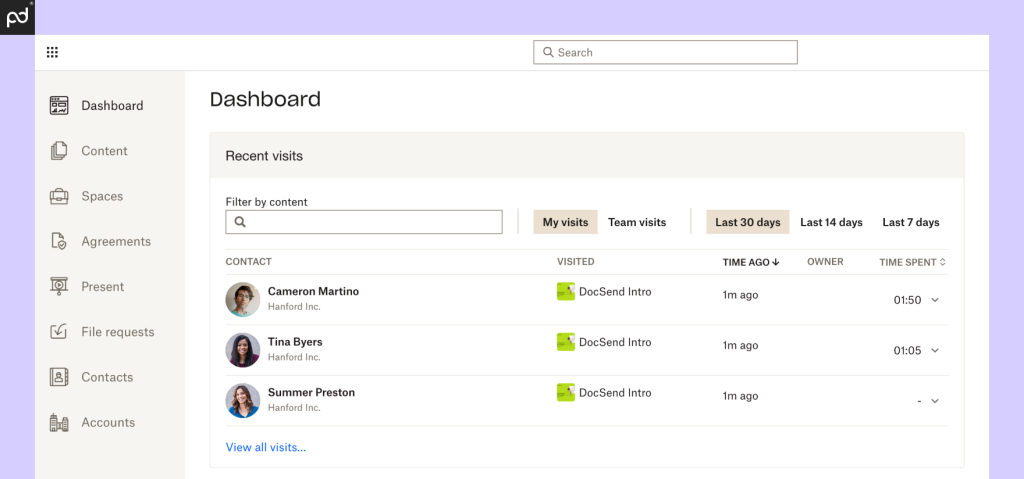
Pricing: Personal ($15); Standard ($65); Advanced ($250); Advanced Data Rooms ($300). Pricing based on monthly subscription. Enterprise plans available.
Ease of use: 8.3/10
Free trial: Yes; 14 days.
Support: Knowledge base; support tickets; phone.
DocSend, part of the Dropbox family of products, stands out in the document management space as a powerful analytics platform.
While many e-signing platforms focus on simply sharing or signing documents, DocSend provides deep insights into how recipients interact with your content.
Quick note: In addition to DocSend, Dropbox also owns HelloSign, a direct competitor to DocuSign. If you’re more interested in a dedicated signing solution than a document sharing platform, check out our full review.
This makes it an invaluable tool for sales, marketing, and other teams who need to understand how recipients interact with their documents. (It’s why we offer a similar toolkit at PandaDoc!)
By tracking views and how much time is spent on each section, it’s easier to understand user engagement and make decisions using a data-driven process.
DocSend’s emphasis on both access control and document management makes it an ideal platform for users who want to share confidential documents while minimizing risk.
Whether teams are pitching to investors, sending proposals to clients, or distributing internal reports, the toolkit that DocSend provides can be used to measure document impact while keeping data secure.
DocuSign
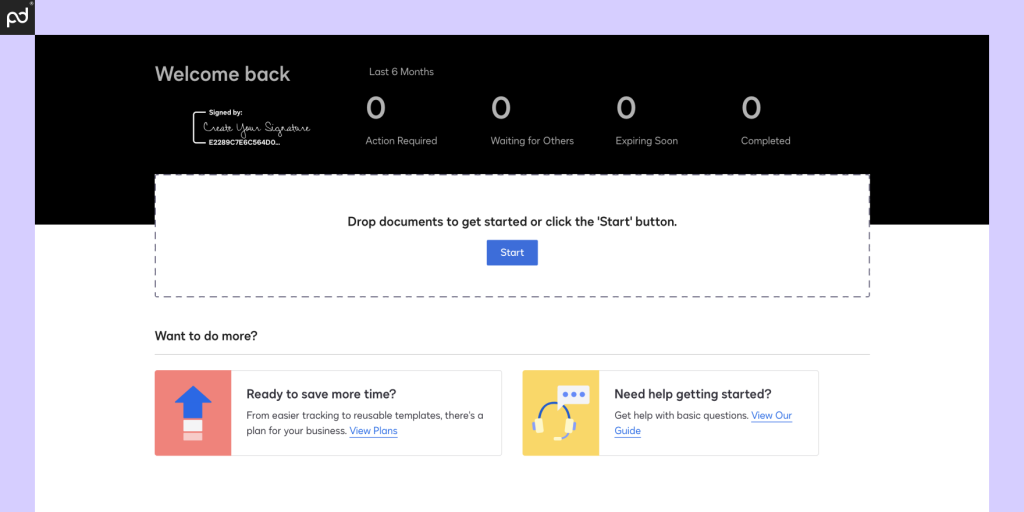
Pricing: Personal ($15); Standard ($45); Business Pro ($60). Enterprise pricing available. All pricing based on month-to-month commitment.
Ease of use: 9.0/10
Free trial: Yes; 30 days.
Support: Knowledge base; support tickets; additional support plans sold as separate packages.
DocuSign has solidified its position as a leader in the eSignature market, revolutionizing how businesses and individuals handle agreements and contracts.
Although many competitive tools offer electronic signatures, DocuSign stands out for its comprehensive suite of features, general ease of use, and its focus on legality and security.
This makes it the go-to choice for industries where compliance and risk mitigation are paramount.
From real estate transactions to HR onboarding, DocuSign streamlines workflows and ensures legally binding agreements.
The platform’s broad range of integrations — from popular CRM platforms to cloud storage solutions — allows it to seamlessly fit into nearly any existing business processes.
Additionally, DocuSign’s commitment to important security features like authentication and encryption can deliver peace of mind to users who need to deal with sensitive documents.
DocuSign vs DocSend at a glance
Want to see how DocSend and DocuSign compare to one another?
In the following sections, we’ll drill down on the key differences between these two platforms.
For now, here’s a quick overview of the key features that each platform has to offer:
| Plan Details | DocuSign | DocSend |
|---|---|---|
| Plan | Business Pro | Standard |
| Pricing | $60/month | $65/month |
| Core product | ||
| E-signature capture | ✓ | ✓ |
| Real-time audit trail | ✓ | ✓ |
| Notifications | ✓ | ✓ |
| Language support | ✓ | ✓ |
| Mobile app | ✓ | X |
| Reporting tools | ✓ | ✓ |
| E-signing features | ||
| Signing order | ✓ | X |
| Send to multiple recipients | ✓ | Max 10 |
| Bulk send | ✓ | X |
| In-person signing | ✓ | X |
| Collaboration tools | ✓ | ✓ |
| Signer attachments | ✓ | via File Requests |
| Payment gateway | ✓ | X |
| Document prep | ||
| Drag & drop fields (PDF) | ✓ | ✓ |
| Create reusable templates | ✓ | X |
| From-scratch document builder | X | X |
| Pre-built template library | X | X |
| Form creation | ✓ | X |
| Custom branding | ✓ | ✓ |
| Integrations & API | ||
| Import & storage | ✓ | ✓ |
| CRM | X | $ |
| Productivity | ✓ | |
| API | $ | X |
| Support | ||
| Email / ticketing support | ✓ | ✓ |
| Chat support | X | ✓ |
| Knowledge base | ✓ | ✓ |
| Phone | X | ✓ |
| Premium support options | $ | X |
To compare features by cost, the chart above compares DocuSign’s Business Pro plan with DocSend’s Standard plan.
Both of these plans cost $65/month or around $45/month when billed annually.
Keep in mind that both platforms offer higher-end solutions for users who need expanded capabilities.
DocuSign users can step into Enhanced Plans by contacting the sales team for a customized solution.
Meanwhile, DocSend users can move up to the Advanced plan and beyond at a substantial price increase.
One other important aspect to consider is transaction limits.
- DocuSign limits users to 100 envelopes per user/year.
- DocSend has no limit for e-signature capture.
Broadly speaking, DocuSign limits usage on both an annual and monthly basis by capping the number of transactions that the platform can facilitate each year.
There is some flexibility, depending on how documents are bundled and distributed. For example, sending a bundle of five documents to five recipients at the same time only counts as one envelope — exactly the same as when sending one document to one recipient.
However, it’s still a transaction limit and a relatively restrictive one for power users in key sectors like sales, legal, and HR.
While DocuSign does allow users to purchase additional envelopes — thereby increasing overall plan costs — doing so may be less appealing when competitors like DocSend have no transaction limits in the first place.
Requirements, workflows & pricing
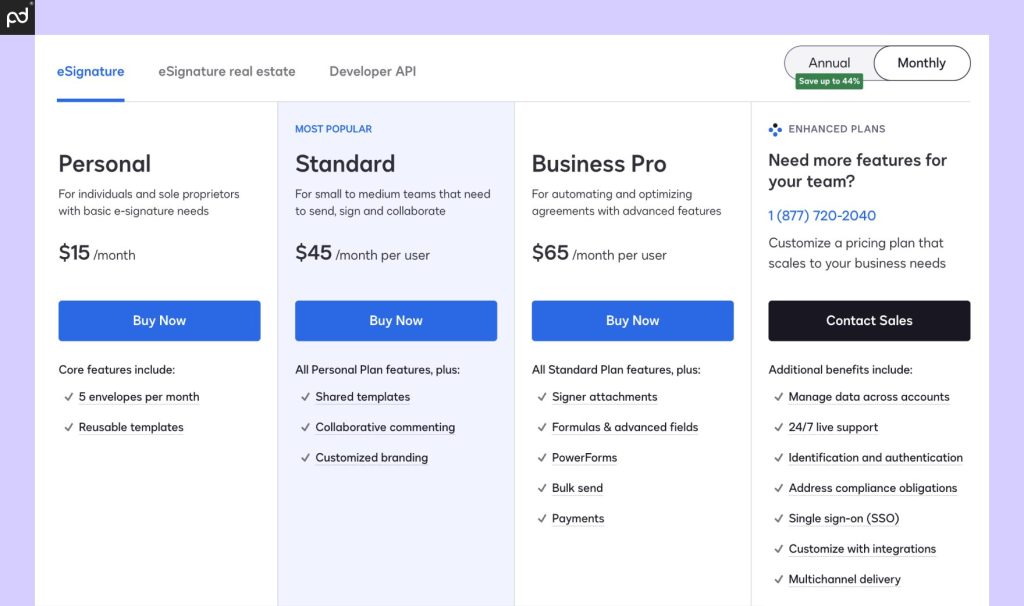
Although DocSend and DocuSign fill similar niches in the document workflow, they’re aimed at separate problems.
DocuSign is the industry standard in e-signing solutions.
The platform invites users to upload their documents into the DocuSign interface. Once uploaded, users can prepare documents for e-signing using drag-and-drop tools, and then send those documents to recipients for secure, user-friendly e-signing.
Assuming that you haven’t invested in other DocuSign products like DocGen or CLM, your experience with DocuSign likely ends with the successful capture of a recipient signature.
It’s a simple and straightforward process that attaches itself to the end of any document workflow.
Put another way: Users can create documents in any word processing software (Google Docs, Microsoft Word, etc.) and then upload that document to DocuSign to begin the e-signing process.
The platform won’t assist with document creation, like you’ll see with some competitors, but it offers some extensibility for smaller tasks like payment capture and limited form generation.
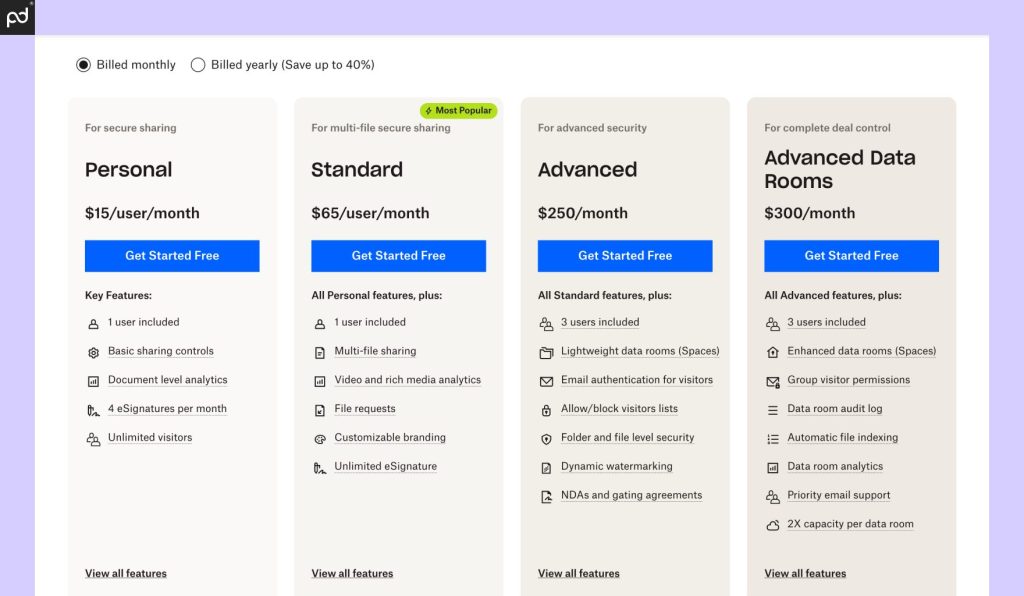
By comparison, DocSend aims to tackle an entirely separate problem.
Rather than facilitating e-signatures — which DocSend supports — the platform is more focused on giving users the ability to share documents with recipients while gathering data and insights on visitors. (DocSend’s analytics are similar to what we offer at PandaDoc.)
DocSend’s intended purpose is to facilitate secure document and file sharing between collaborators and organizations in a way that allows sending parties to maintain control and confidentiality of their information.
The platform highlights its features around document tracking, including real-time notifications, location access notifications, and aggregated and individual visitor dashboards.
On higher-end plans, it’s even possible to prompt users to sign NDAs and gating agreements that must be completed prior to viewing an intended document.
Allow/block lists, custom branding, and dedicated data rooms are also available.
On top of all that, DocSend can be used to facilitate electronic signatures — just like DocuSign. Users can upload documents, leverage the onboard drag-and-drop interface to prepare documents for e-signing, and dispatch them to senders via the platform’s sending tools.
A key difference between these platforms is DocSend’s ability to send more than PDF documents.
With DocSend, users can upload various file types and formats into a dedicated data room and then invite users onto the platform to review.
This opens up a variety of use cases that go beyond e-signing, far beyond the scope of service that DocuSign provides.
Our suggestion
Although DocSend is positioned as an analytics platform, it’s entirely capable of capturing e-signatures.
Its strength and focus are on measuring user engagement and helping teams better understand how shared content gains traction with intended recipients.
Overall, DocSend lacks some of the extensibility seen in DocuSign, such as the ability to capture payments or generate embeddable forms.
On the other hand, DocuSign is more heavily focused on e-signing and expanded capabilities around the digital signature process.
While this platform offers some basic tracking and data gathering (such as audit trails for document authenticity), it won’t offer much by way of tracking and insights.
To get the best of what both platforms offer, you’ll need a more comprehensive solution, like PandaDoc.
- DocSend can facilitate e-signatures but exchanges some extensibility in favor of deeper analytics and more versatile file handling.
- DocuSign offers flexible e-signing and flexibility around this process, but it lacks strong analytics options and enforces strict usage limitations.
- PandaDoc offers strong e-signing and analytics tracking, as well as other tools like document creation, acting as one of the market’s strongest all-around contenders.
E-signing & document preparation
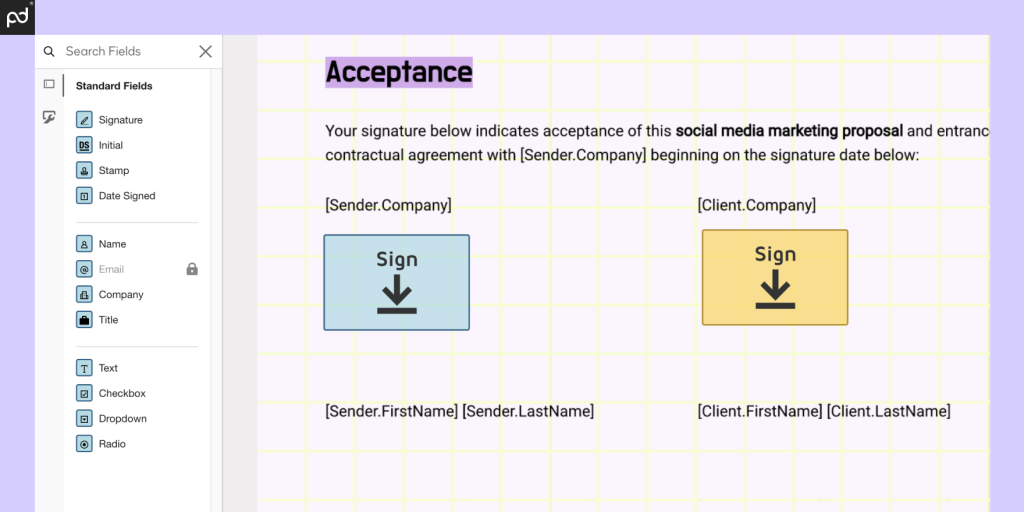
Although similar, the document preparation and e-signing process for both DocuSign and DocSend has a few key differences to consider.
With DocuSign, users will need to begin by uploading their document in an acceptable format. The platform accepts multiple document types, including DOCX, PDF, CSV, PPT, and many others. From there, users can utilize the onboard drag-and-drop interface to add various data and signature fields to the document.
Text boxes, initials, dates, and more can be added easily with the same toolkit and quickly assigned to various signers within the document.
Once the document is prepared, users can send it to recipients via email (or SMS, for an additional fee), with a personalized message.
Signers can access the document via their email link and review it on any internet-connected device.
DocuSign will guide users through this process by highlighting where documents must be signed and initialed in order for the document to be completed.
If payments need to be captured when the document is signed, DocuSign will prompt users for their payment information and facilitate that transaction.
Once all recipients have signed and the document is complete, everyone receives a notification and the document is made available for download by all parties, along with a detailed audit trail for legal purposes (more on this below).
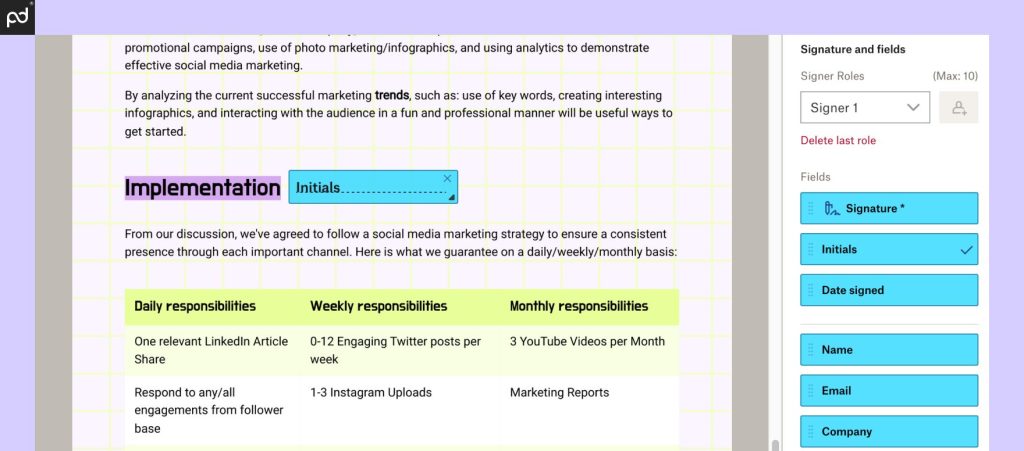
DocSend’s process follows the same flow that you’ll find in DocuSign.
Users will need to upload one of DocSend’s accepted filetypes to begin the e-signing process. Notably, DocSend can accept a greater selection of file types than DocuSign — including audio and video files — which can be signed with a one-click signable link.
Specifically for document formats like DOCX, PDF, and others, DocSend provides an interactive, drag-and-drop visual interface that users can use to prepare their document for e-signing.
Once the document is prepared and all fields are assigned, the document can be sent to users via email or link.
Beyond that basic process, DocSend relies heavily on its virtual data rooms called Spaces (similar to virtual data rooms at PandaDoc).
Available starting on the Standard plan, Spaces act as a centralized repository where all relevant documents are gathered together and shared simultaneously with a single link.
From a document management perspective, Spaces provide additional oversight for admins by providing an easy way to manage link permissions and maintain version control.
It’s a form of administration that you won’t see in DocuSign at all, apart from the ability to bundle documents together in a single send, which isn’t the same thing.
Our suggestion
Both DocuSign and DocSend offer robust e-signing capabilities and follow a (roughly) similar process when preparing documents.
With that in mind, the ideal choice will depend on your specific needs.
If your priority is comprehensive document management and access control, DocSend uses data rooms to lean more heavily into those features as part of its preparation and distribution process.
However, if you’re looking for added extensibility around the e-signing process and want support for things like payment integration or form generation, DocuSign is probably a better fit.
- DocSend excels in document management and access control by leveraging its virtual data rooms.
- DocuSign supports a broader range of extensible functionality around its e-signing processes.
- PandaDoc gives users the best of both worlds by offering advanced access controls, virtual data rooms, payment gateways, and more.
Analytics & tracking
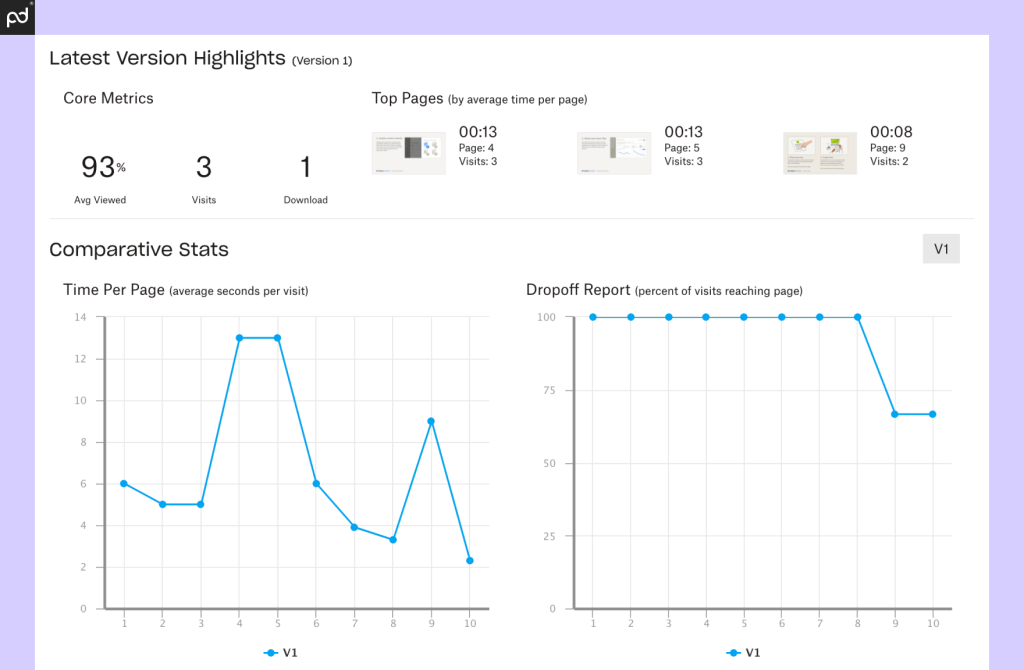
So far, we’ve covered points where DocuSign and DocSend offer similar functionality.
However, when it comes to analytics and tracking, these platforms diverge significantly.
Many of DocSend’s core features center around its ability to track user activity and document engagement.
Similar to PandaDoc document analytics, DocSend users will be able to see a variety of statistics.
At the document level, it’s possible to see how recipients visited a document, how long they spent on each page, and where they ultimately left the document.
From there, it’s easy to map engagement trends and figure out which pages in the document are performing well.
Notably, DocSend offers comparative statistics for different document versions.
When a new version of the same document is uploaded, the stats for each version can be compared side-by-side to better analyze performance.
Above the document level, Spaces have their own set of analytics.
Within Spaces, it’s possible to see the total number of visitors, who visited, what documents were visited and downloaded, and how much cumulative time was spent in the room.
While these detailed insights can be used to help organizations improve their document design, they also act as a means to check for understanding.
All activity is tracked and monitored, so it’s easy to ensure that visitors have reviewed all relevant documentation prior to making a big decision.
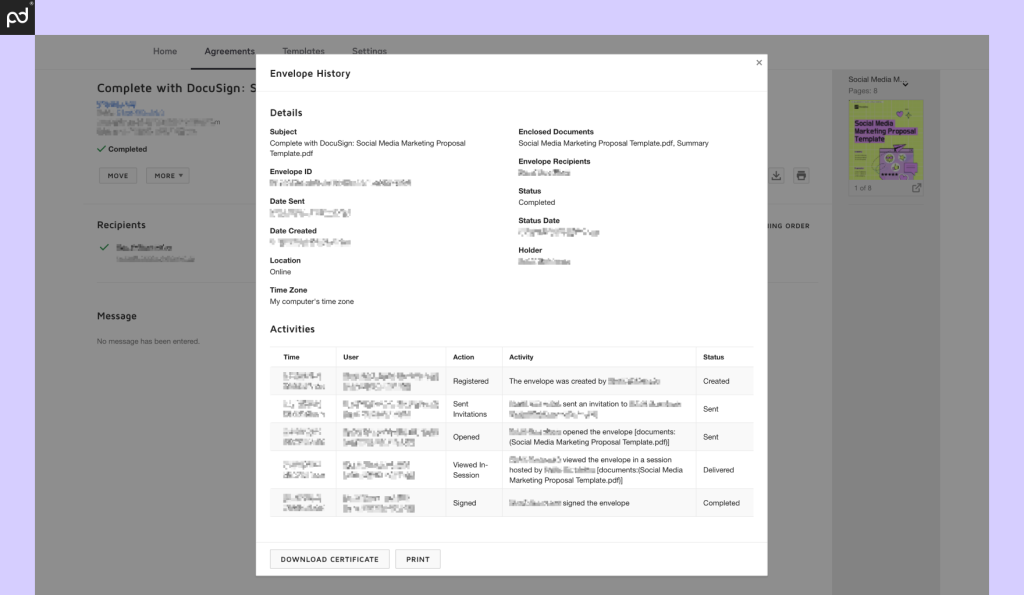
Comparatively, DocuSign only provides some basic tracking features. It’s possible to see when a document was sent, viewed, and signed.
However, the platform lacks the ability to provide in-depth, page-level analytics that you’ll find in DocSend.
This is largely by design. As a cloud-based SaaS company, DocuSign has diversified its product lineup in a way that offers a clear distinction in capabilities.
DocuSign eSign specializes in electronic signature capture, and the company has very clear guardrails for what features should be included in that product offering.
With DocuSign, it’s possible to get some additional insights into your contracts and agreements, but you may need to purchase an additional product like DocuSign Insight or DocuSign Monitor in order to see the data.
Even here, the data that DocuSign provides is centered more around contract summaries or document security than engagement and usage.
Outside of usage data, DocuSign does provide basic information via audit trails.
This data is captured when envelopes are accessed and will provide identifying information that can be used to validate the authenticity of an e-signature.
DocSend also provides this feature for all documents and even includes audit trails for data rooms on higher-end plans.
Our suggestion
If tracking access and engagement for your documents is essential, DocSend is a superior choice when compared to DocuSign.
Both organizations offer basic tracking and audit trails.
However, beyond that baseline, DocSend will offer a far greater collection of insights that teams can use to improve document readability and acceptance.
- DocSend is the superior choice for tracking and analytics.
- DocuSign’s e-signing platform only provides basic tracking and access information.
Integrations & extensibility
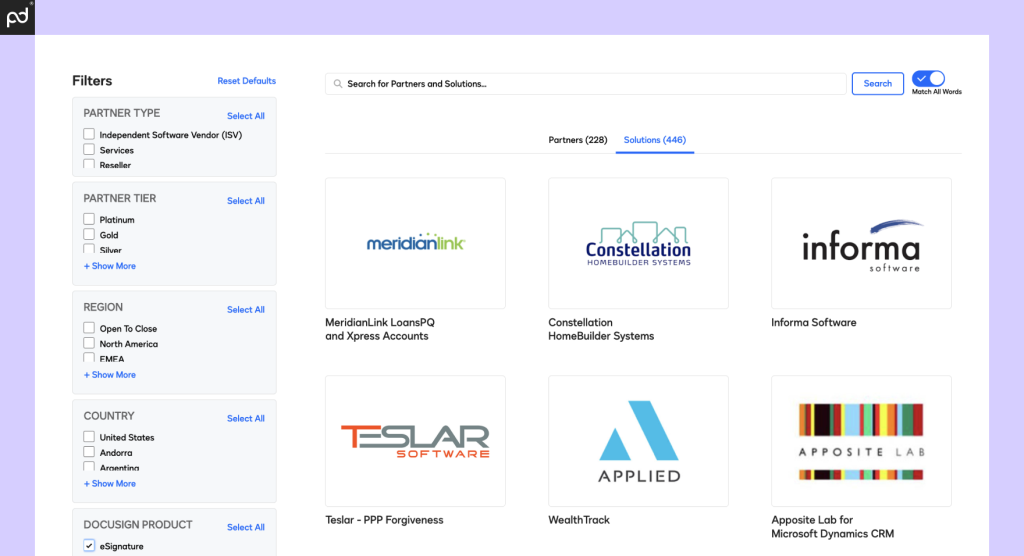
Where DocSend excels in document analytics, DocuSign excels in its ability to integrate with existing tech stacks and improve its service offering.
To date, DocuSign boasts the largest integration library of any e-signing tool on the market. Users can pick from 400+ solutions and 200+ partner integrations, most of which are available for all plan tiers.
Keep in mind that extremely popular integrations like connections to Salesforce, NetSuite, and Microsoft Dynamics, are only available via Enhanced Plans.
However, niche integrations with obscure point-of-sale and CRM connectors are regularly available via DocuSign.
The platform also offers native connectivity with Microsoft 365, Google Drive, and other productivity applications.
All of this gives DocuSign a ubiquity that isn’t common with other e-signing platforms.
On top of that, it’s also possible to use DocuSign’s comprehensive API to develop custom integrations, further extending the platform’s capabilities to meet a variety of unique business needs.
Even setting all of that aside, DocuSign provides payment gateways and form creation that DocSend simply doesn’t offer.
Users will be able to do more with this e-signing tool than monitor engagement and track usage.
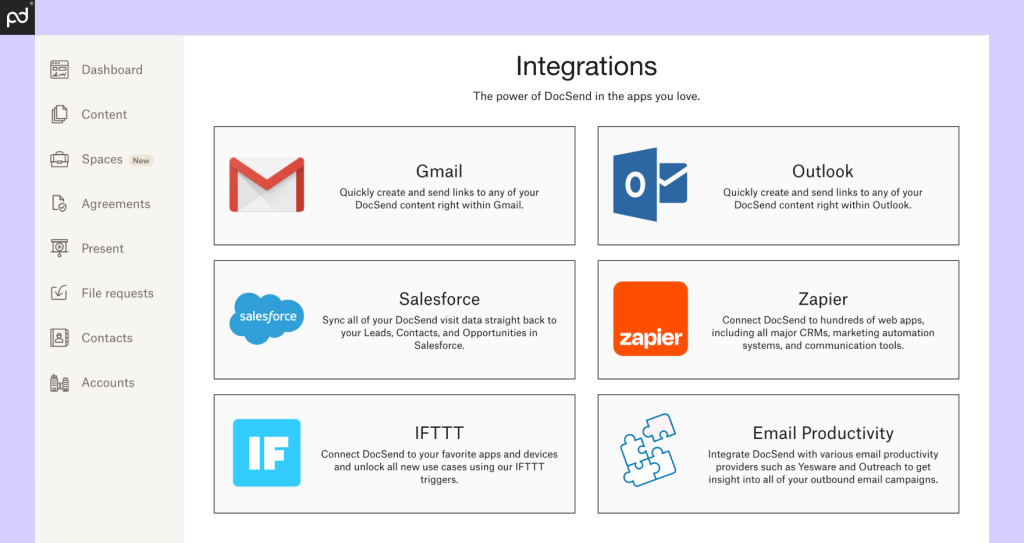
By comparison, DocSend falls woefully short in this category.
DocSend users can connect via a limited selection of native integrations. Most of these integrations are connected to email productivity tools (Outlook, Gmail, etc.). Salesforce is the one exception, and that connectivity is only available as a paid add-on.
It’s possible to use Zapier and IFTTT to add some connectivity with other tools, but the capabilities and integrations will vary based on the software at hand.
Overall, DocSend’s lack of native connectivity means that the platform is largely a standalone product. Users can import documents and data and leverage DocSend for reviews and e-signing. However, the platform won’t integrate natively with the rest of your tech stack and will always feel like a separate piece of a unified workflow.
Our suggestion
While DocSend has some integration options, it can’t compare to what DocuSign offers on its most basic plans.
The ability to connect and integrate with other apps and platforms is one of the key elements to DocuSign’s success. Between its flexible API and native integrations with hundreds of obscure softwares, it’s a go-to solution when trying to connect e-signing to an otherwise-complete workflow.
- DocuSign offers superior integrations and connectivity, far beyond what most other e-signing platforms can provide.
- DocSend offers some connectivity, but it’s largely limited to third party integrations and a few productivity connections.
- PandaDoc is a great option if you want a mix of strong integrations and powerful document analytics.
Alternatives to DocSend & DocuSign
It probably goes without saying, but DocSend and DocuSign aren’t the only platforms for secure document sharing and document management.
Other tools exist that provide similar services and functionality. Below, we’ve listed a few alternatives to these e-signing and sharing platforms.
Take a closer look:
Your experience between platforms is likely to vary.
Some platforms, like PandaDoc or GetAccept, specialize in a combination of content management and process automation meant to streamline various aspects of your document workflow.
Other tools, like Adobe’s Acrobat Sign, provide e-signature solutions in addition to real-time PDF editing.
The digital signature market is highly competitive, and almost every organization tries to offer a unique combination of features in order to appeal to startups, small businesses, and enterprise teams alike.
Better documents. Better e-signing. PandaDoc.
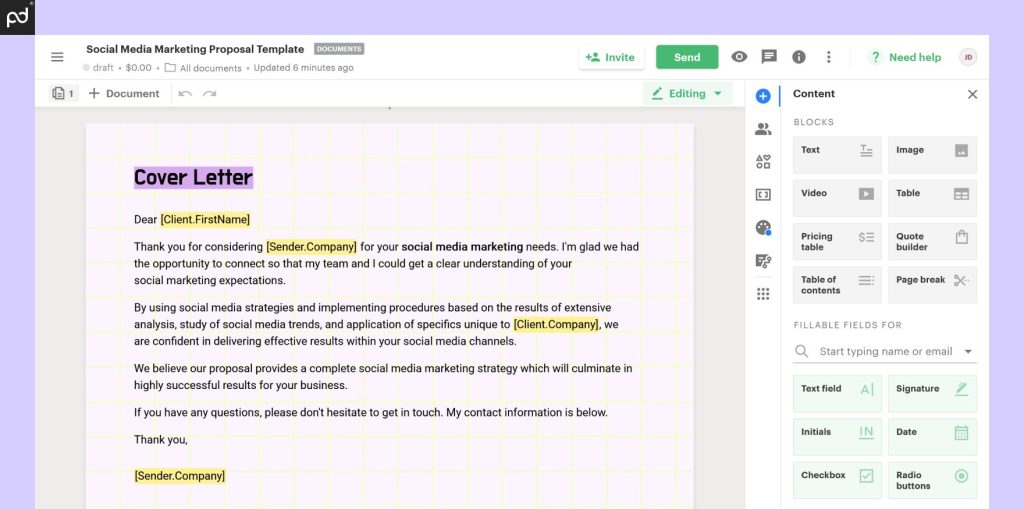
Without a doubt, DocuSign and DocSend are strong contenders for users who need to both share and e-sign documents.
But, while both platforms offer a powerful toolkit, both limit themselves to sharing, distribution, and signing.
If you’re looking to do more with your documents, don’t overlook PandaDoc.
Our platform combines secure e-signing and sharing with from-scratch document creation, so that teams can handle more of their document processes in one place.
Beyond robust document creation and collaboration tools, PandaDoc also offers 1000+ templates to kickstart your projects, a content library for even faster document creation, and round-the-clock live customer support.
You’ll even find dedicated mobile apps for Android and iOS so that you can manage documents on the go.
Take advantage of our free 14-day trial or schedule a demo to experience how PandaDoc can revolutionize your document workflow.
Disclaimer
Parties other than PandaDoc may provide products, services, recommendations, or views on PandaDoc’s site (“Third Party Materials”). PandaDoc is not responsible for examining or evaluating such Third Party Materials and does not provide any warranties relating to the Third Party Materials. Links to such Third Party Materials are for your convenience and do not constitute an endorsement of such Third Party Materials.
Originally published March 23, 2022, updated August 20, 2024


